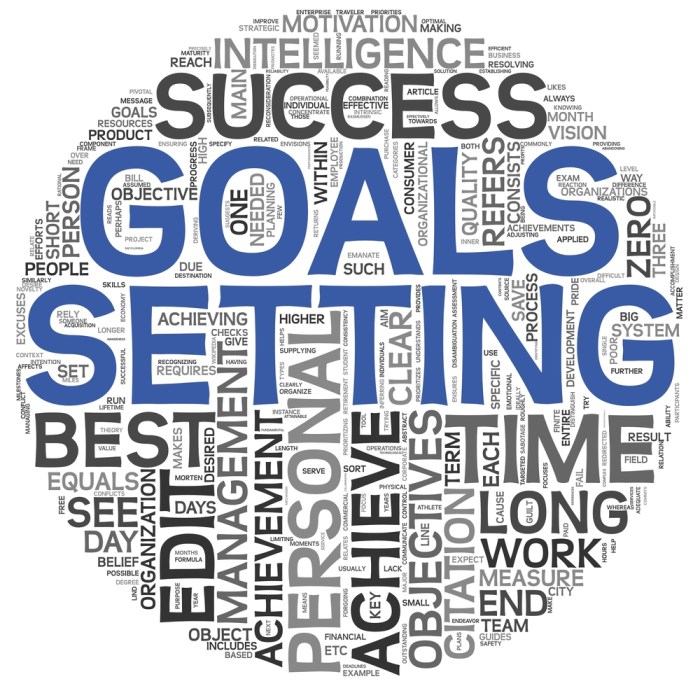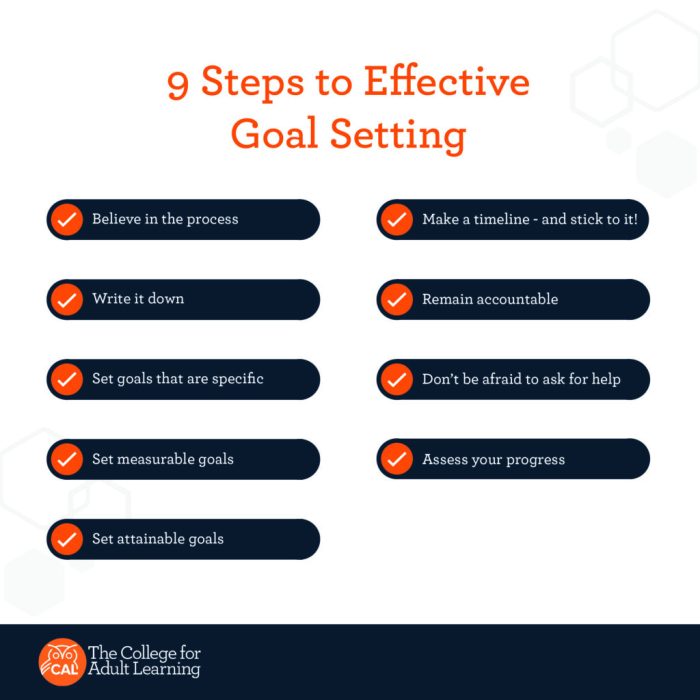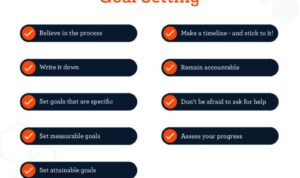Goal Setting Techniques dive into the essence of setting clear and measurable goals, exploring examples of short-term and long-term goals while delving into the SMART criteria for effective goal setting. Get ready to level up your goal-setting game!
Goal Setting Techniques

Setting clear and measurable goals is crucial for success in any endeavor. It provides a clear direction, helps track progress, and increases motivation and accountability.
Short-term and Long-term Goals
- Short-term goals: These are goals that can be achieved in a relatively short period, usually within days, weeks, or months. An example is completing a project by the end of the week.
- Long-term goals: These are goals that take a longer time to achieve, usually spanning months, years, or even a lifetime. An example is starting a successful business within the next five years.
SMART Criteria for Effective Goals
- Specific: Goals should be clear and specific, avoiding vague language.
- Measurable: Goals should be quantifiable and include criteria for measuring progress.
- Achievable: Goals should be realistic and attainable within the given resources and timeframe.
- Relevant: Goals should align with overall objectives and be relevant to the individual or organization.
- Time-bound: Goals should have a deadline or timeframe for completion to create a sense of urgency and focus.
Popular Goal Setting Methods
Setting goals is crucial for success, but the method you choose can greatly impact your outcomes. Let’s explore some popular goal setting methods below.
Difference Between Outcome Goals and Process Goals
Outcome goals focus on the end result you want to achieve, such as winning a competition or landing a job. Process goals, on the other hand, involve the actions and behaviors you need to take to reach that outcome. While outcome goals provide a clear target, process goals help you stay focused and motivated along the way.
1-3-5 Goal Setting Method vs. OKR Framework, Goal Setting Techniques
The 1-3-5 goal setting method involves setting 1 long-term goal, 3 medium-term goals, and 5 short-term goals to break down your objectives into manageable steps. On the other hand, the OKR (Objectives and Key Results) framework is more focused on setting ambitious, measurable goals and tracking progress using key results. While the 1-3-5 method provides a structured approach, OKRs emphasize clarity and alignment across teams.
Eisenhower Matrix for Prioritizing Goals
The Eisenhower Matrix, also known as the Urgent-Important Matrix, helps you prioritize tasks and goals based on their urgency and importance. By categorizing goals into quadrants (urgent and important, not urgent but important, urgent but not important, not urgent and not important), you can identify what needs immediate attention and what can be delegated or delayed. This method is effective for maximizing productivity and focusing on high-priority goals.
Goal Setting Strategies
Setting goals is crucial for personal growth and career success. Here are some effective strategies to help you achieve your goals.
Setting Stretch Goals for Personal Growth
Setting stretch goals involves aiming for objectives that may seem challenging or even impossible at first. However, by pushing yourself to achieve these goals, you can experience significant personal growth and development. Embracing stretch goals can help you expand your skills, knowledge, and capabilities beyond your comfort zone, leading to greater self-improvement and confidence.
- Challenge yourself by setting goals that are slightly out of reach but still achievable with effort and dedication.
- Embrace failure as a learning opportunity and a stepping stone towards success.
- Stay motivated and focused on your long-term vision while pursuing your stretch goals.
- Celebrate small victories along the way to stay encouraged and motivated.
Breaking Down Big Goals into Smaller Tasks
Breaking down big goals into smaller, manageable tasks is a key strategy for success. By dividing your goals into smaller steps, you can make progress consistently and avoid feeling overwhelmed. This approach helps you stay organized, focused, and motivated throughout your goal-setting journey.
- Start by identifying the main objective or end goal you want to achieve.
- Break down the goal into smaller tasks or milestones that you can work on one at a time.
- Set deadlines for each task to create a sense of urgency and accountability.
- Track your progress regularly and adjust your plan as needed to stay on track.
Designing a Roadmap for Career Goals
Designing a roadmap for setting and achieving career goals is essential for long-term career success. By creating a strategic plan, you can Artikel your career objectives, identify the steps needed to achieve them, and track your progress along the way. This roadmap serves as a guide to help you stay focused, motivated, and on track towards fulfilling your career aspirations.
- Define your career goals and objectives, both short-term and long-term.
- Identify the skills, knowledge, and experience required to reach your career goals.
- Create a timeline with milestones and deadlines to track your progress and stay accountable.
- Seek feedback and mentorship to help you navigate your career path and make informed decisions.
Motivation and Goal Setting: Goal Setting Techniques

Motivation is a key factor in achieving set goals. It provides the drive and determination needed to overcome obstacles and stay focused on the desired outcome. Without motivation, it can be challenging to make progress towards achieving our goals.
When it comes to staying motivated throughout the goal-setting process, there are a few tips to keep in mind. Firstly, setting clear and specific goals can help maintain motivation as it gives a clear target to work towards. Breaking down larger goals into smaller, manageable tasks can also prevent overwhelm and boost motivation.
Another important aspect to consider is the difference between intrinsic and extrinsic motivation. Intrinsic motivation comes from within, driven by personal satisfaction, enjoyment, or a sense of purpose. On the other hand, extrinsic motivation comes from external rewards or recognition. While both types of motivation can be effective in achieving goals, intrinsic motivation tends to be more sustainable and fulfilling in the long run.
Impact of Intrinsic versus Extrinsic Motivation
- Intrinsic motivation is often associated with higher levels of engagement and creativity, leading to a deeper sense of fulfillment when goals are achieved.
- Extrinsic motivation, while effective in the short term, may lead to burnout or a lack of satisfaction if the external rewards are not fulfilling.
- Finding a balance between intrinsic and extrinsic motivation can help maintain motivation levels and increase the likelihood of successfully achieving set goals.

